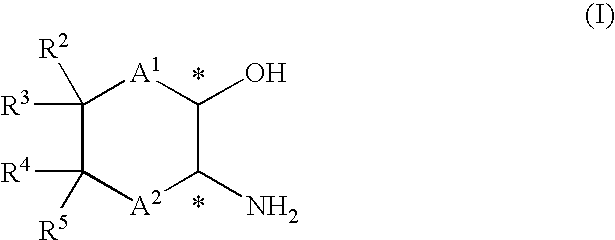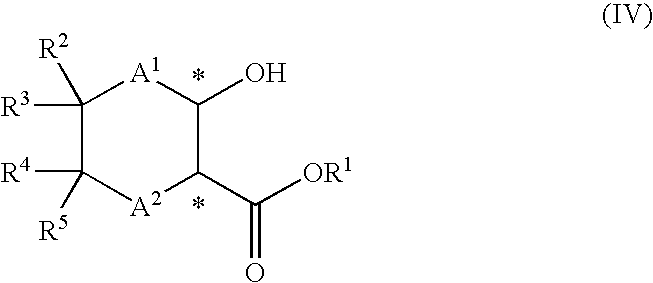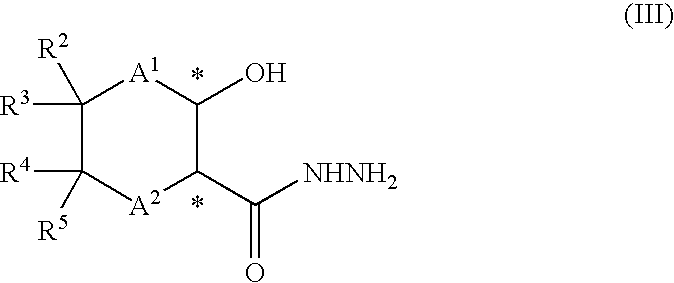Process for the production of optically active amino alcohols
a technology of amino alcohols and amino alcohols, which is applied in the field of process for the production of optically active amino alcohols, can solve the problems that conventional methods are still not suitable for industrial application in view of economy and efficiency, and achieve the effects of convenient availability, excellent economic and efficiency, and less expensive materials
- Summary
- Abstract
- Description
- Claims
- Application Information
AI Technical Summary
Benefits of technology
Problems solved by technology
Method used
Image
Examples
example 1
Synthesis of Methyl
(R,R)-2-hydroxycyclopentanecarboxylate
[0138]To a one-liter autoclave was added 0.419 g (0.509 mmol) of [Me2NH2][{RuCl ((R)-segphos)}(μ-Cl)3], then a solution containing 72.41 g (509.3 mmol) of methyl 2-oxocyclopentanecarboxylate, 253 mL of methylene chloride and 36 mL of methanol was added and the mixture was stirred at 40° C. for 18 hours under 1 MPa of hydrogen pressure. After cooling, hydrogen was discharged, the solvent was recovered and the residue (100.3 g) was distilled under reduced pressure (70 to 80° C. / 93.3 Pa) to give 71.15 g of the title compound. The yield was 88%. Enantiomer excessive rate (hereinafter, referred to as “% ee”) and diastereomer excessive rate (hereinafter, referred to as “% de”) of this compound were analyzed by gas chromatography (column: Chirasil DEX-CB) and found to be 99.3% ee and 96.7% de, respectively.
[0139]1H-NMR (500 MHz) δ (CDCl3): 1.6–1.8 (m, 4H), 2.0 (m, 2H), 2.7 (br, 2H), 3.7 (s, 3H), 4.4 (m, 1H).
example 2
Synthesis of Methyl
(S,S)-2-hydroxycyclopentanecarboxylate
[0140]To a 100-ml autoclave were added 96.9 mg (0.106 mmol) of [{RuCl(p-cymene)(S)-segphos}]Cl, then a mixed liquid comprising 3.00 g (21.1 mmol) of degassed methyl 2-oxocyclopentanecarboxylate, 15.7 mL of methylene chloride and 2.3 mL of methanol was added and the mixture was stirred at 60° C. for 18 hours under 5 MPa of hydrogen pressure. After cooling, hydrogen was discharged, the solvent was recovered and the residue (3.05 g) was distilled using a Kugelrohr (93.9 Pa) to give 2.33 g of the title compound. The yield was 73%. The resulting product was analyzed and measured by the same manner as in Example 1 whereupon the results were 99.3% ee and 94.2% de.
[0141]1H-NMR (200 MHz) δ (CDCl3): 1.6–1.8 (m, 4H), 2.0 (m, 2H), 2.7 (br, 2H), 3.7 (s, 3H), 4.4 (m, 1H).
example 3
Synthesis of Ethyl
(R,R)-2-hydroxycyclohexanecarboxylate
[0142]To a one-liter autoclave was added 0.539 g (0.588 mmol) of [{RuCl (p-cymene)(R)-segphos}]Cl, then a solution containing 100.0 g (587.5 mmol) of degassed ethyl 2-oxocyclohexanecarboxylate and 400 mL of methylene chloride was added and the mixture was stirred at 40° C. for 22 hours and then at 60° C. for 91 hours under 2 MPa of hydrogen pressure. After cooling, hydrogen was discharged, the solvent was recovered and the residue (123.91 g) was distilled under reduced pressure (80 to 90° C. / 93.3 Pa) to give 99.37 g of the title compound. The yield was 98%. The resulting product was analyzed and measured by the same manner as in Example 1 and the results were 97.5% ee and 87.5% de.
[0143]1H-NMR (200 MHz) δ (CDCl3): 1.3 (t, J=7.1 Hz, 3H), 1.2–1.4 (m, 3H), 1.6–1.8 (m, 3H), 2.0 (m, 2H), 2.2 (m, 1H), 2.8 (d, J=3.2 Hz, 1H), 3.8 (m, 1H), 4.2 (q, J=7.1 Hz, 2H).
PUM
| Property | Measurement | Unit |
|---|---|---|
| temperature | aaaaa | aaaaa |
| temperature | aaaaa | aaaaa |
| temperature | aaaaa | aaaaa |
Abstract
Description
Claims
Application Information
 Login to View More
Login to View More - R&D
- Intellectual Property
- Life Sciences
- Materials
- Tech Scout
- Unparalleled Data Quality
- Higher Quality Content
- 60% Fewer Hallucinations
Browse by: Latest US Patents, China's latest patents, Technical Efficacy Thesaurus, Application Domain, Technology Topic, Popular Technical Reports.
© 2025 PatSnap. All rights reserved.Legal|Privacy policy|Modern Slavery Act Transparency Statement|Sitemap|About US| Contact US: help@patsnap.com



